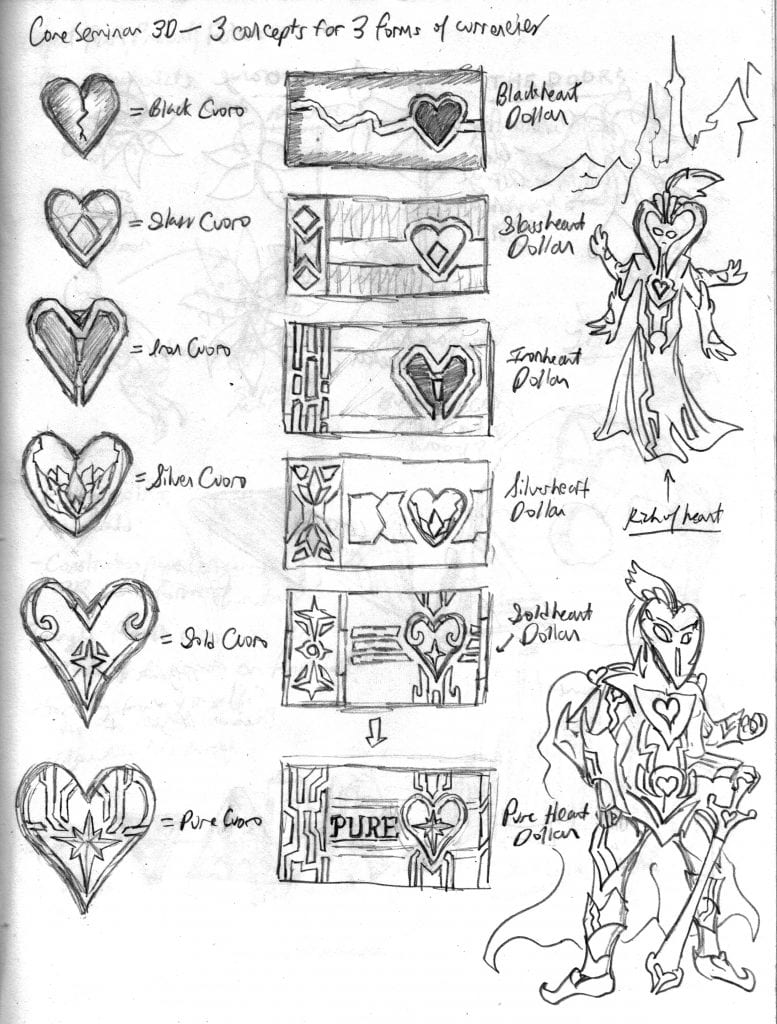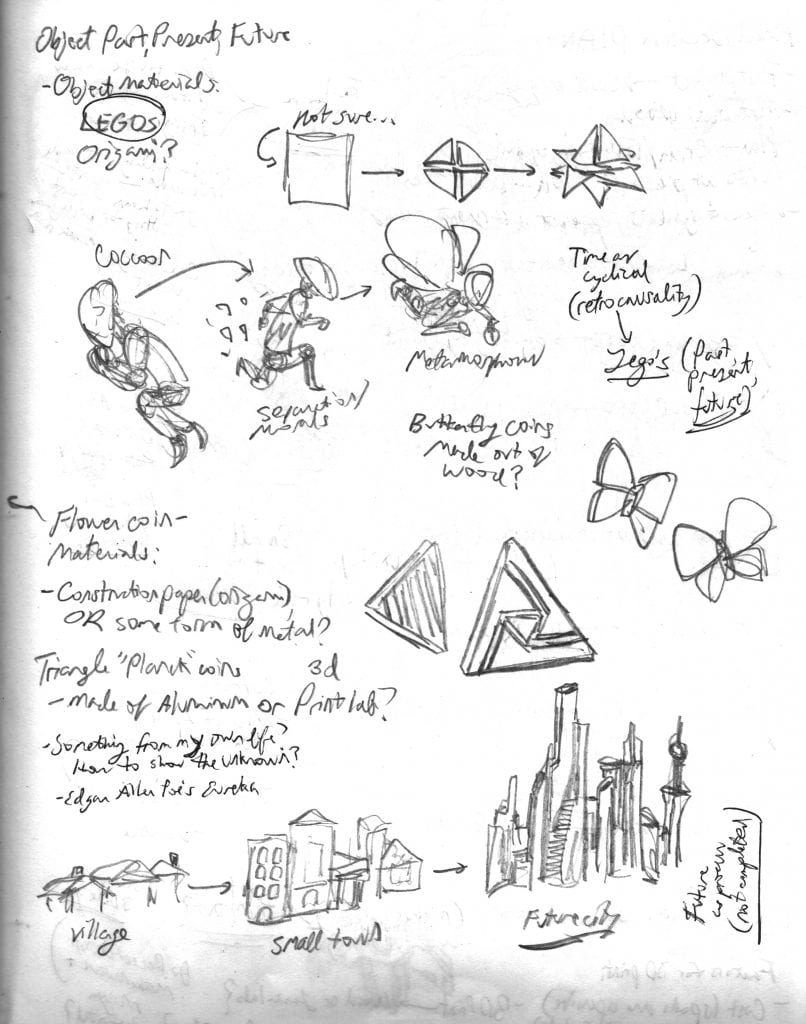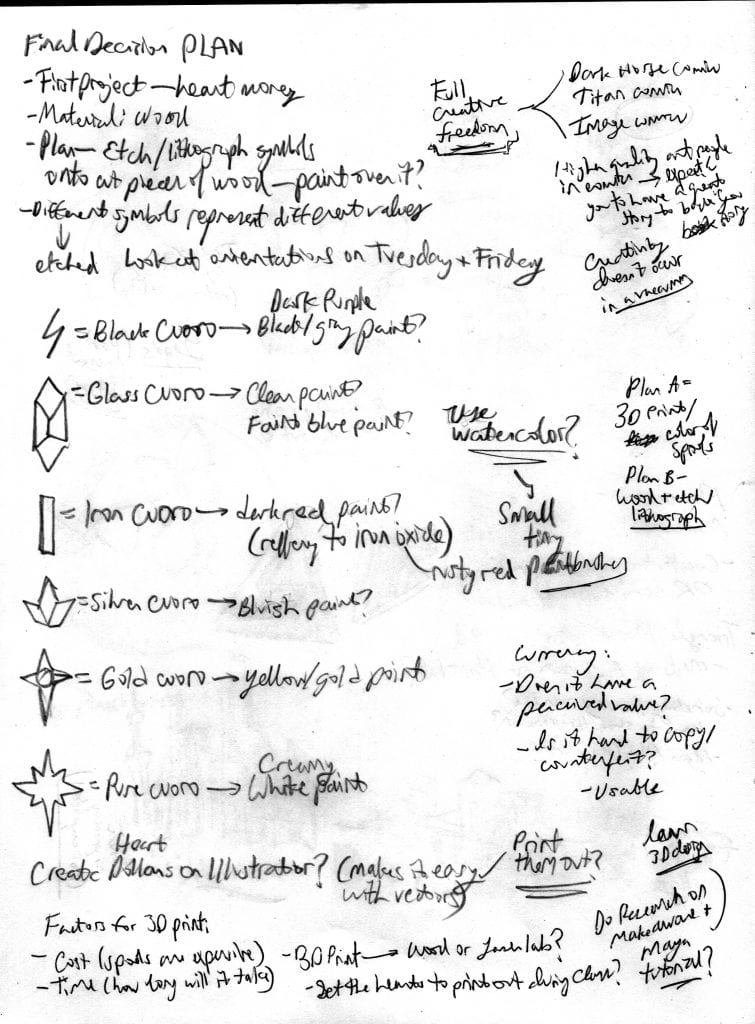For my first Core Seminar 3D class project, I was tasked with creating three concepts (in writing, and in image-based art) for three different made-up currencies, either based on real-life forms of currency (not just coins or dollars!), or on fantasy equivalents. Below I have listed what I think are somewhat unique concepts for my own fictional currencies, which will eventually be realized in 3-dimensional form, alongside sketches:
Love itself as a form of currency— but made physical. In a hypothetical society that uses this form of currency, those with the most love and sincerity and kindness are the wealthiest, and thus can afford to give the most affection. The most selfish and hateful are the poorest. This economic system is somewhat akin to modern “emotional capitalism”, but it also draws inspiration from the mercantile economy of Italy during the Renaissance, specifically in Florence (which became the center of trade and finance in Europe). In this society, the worth of individual “Cuoros” is determined by their purity (just as gold is in real life using the karat system). The more pure the “heart-coin” is, the more it is worth. The value of the overall unit of currency a person possesses (and thus their socioeconomic class) is uniquely linked to their own empathy. Each unit of currency in cents has a dollar equivalent. Below is a list of all the units of currency for the “Cuoro”:
-
- Black Cuoro— similar to the penny. A Blackheart dollar is worth ~ $1 USD
- Glass Cuoro— equivalent to the nickel. A Glassheart dollar is worth ~ $5 USD
- Iron Cuoro— equivalent to the dime. An Ironheart dollar is worth ~ $10 USD
- Silver Cuoro— equivalent to the quarter. A Silverheart dollar is worth $20 USD
- Gold Cuoro— 50-cent coin. A Goldheart dollar is worth $50 USD.
- Pure Cuoro/ Pureheart dollar— worth $100 USD. Larger amounts and conversions to real world currencies (USD) are calculated by multiplying the number of Pureheart dollars by 100. Someone who has ten Pureheart dollars would have $1000. Someone with 10,000 Pureheart dollars is a millionaire. Somebody with 10 million Pureheart dollars is a billionaire in our world. The poor and impoverished usually are denied access to anything beyond silver Cuoros unless they demonstrate genuine kindness to others (i.e not merely doing kind things to get more money).
Tulips were once used as currency and were worth more than gold in Europe. The Dutch used tulips for currency during their Golden Age, which were brought from the Ottomans/Turks. The market boomed for a little while, but not long after tulips reached their peak value, the whole thing collapsed (just like Bitcoin and the “cryptocurrency craze”) in February 1637. This has served as inspiration for me to create a currency based entirely on the freshness and maturity of some alien crop on some alien world. Not long after humans colonize space and come across alien planets, they strike gold on a planet full of fields with a strange plant which secretes a mineral nectar colored like orange and blue amber. Drinking the nectar causes consumers to experience overwhelming joy and pleasure, but it is also quite addictive, and, in high quantities, can cause severe spasms all over the body followed by a fatal aneurysm and internal bleeding. The plant is so gorgeous and rare that it becomes a hot commodity for years. Entire businesses are set up around the transport and growing of these strange plants, and the market booms, until the demand for the flowers surpasses the speed of their growth and production. People beg to have more nectar in higher amounts, and eventually they start dying from the aforementioned spasms and aneurysms, exploding from within from pleasure. They start killing each other for the flowers in low supply, and committing crimes all over the galaxy. When the ruling government finds out about the mass deaths from the alien plants, the value of the alien plant plummets and the market crashes as authorities shut down all businesses responsible for the transport and growing of the alien flowers. Billions of consumers are thrown into insane asylums and rehab facilities, and treated as drug addicts until their withdrawal symptoms subside. The alien world is quarantined, and the flowers are destroyed instance by instance. The flowers most commonly have blue petals, although rare instances have orange petals, and even rarer instances are purple and silver. The rarest instances have gold petals, and their nectar is the most potent— thus they are worth the most.
-
- Blue petal alien flower = 4 petals, satisfactory pleasure and joy for about an hour.
- Orange petal alien flower = 5 petals, great pleasure and joy for several hours.
- Purple and silver flower = 6 petals, amazing pleasure and joy for a day.
- Gold flower = 8 petals, overwhelming pleasure and joy for days if not weeks. Extremely addictive, and can kill the consumer if multiple instances are taken all at once.
The island of Yap in the Solomon Islands once had massive stones called “rei stones” as currency used by the local natives. They’d paddle over across harsh waters on their canoes to carve out the massive stones in Palau, then bring them back to their villages and give them to someone to own. The stones would be placed somewhere and never move when transactions were made— they’d only change owners. The worth of a rei stone would be largely determined by its size. Similarly, the Hitchhiker’s Guide to the Galaxy has the Triganic Pu and Ningis. The wiki (http://hitchhikers.wikia.com/wiki/Ningi), says this: “The Triganic Pu is a unit of galactic currency, with an exchange rate of eight Ningis to one Pu. This is simple enough, but, since a Ningi is a triangular rubber coin six thousand eight hundred miles along each side, no one has ever collected enough to own one Pu. Ningis are not negotiable currency, because the Galactibanks refuse to deal in fiddling small change”. Rei stones and Ningis are both absolutely massive in size— so much so that trying to create a project out of them would be extremely difficult.
Thus, creating a currency whose coins are tiny might be interesting (although they could be easily lost). In physics and cosmology, there’s a term called the “Planck length” and “Planck time”. They are misconceived often as the minimum measurements for size and time in spacetime, but in actuality represent lengths in which quantum effects become apparent, and in which ideas of physics, space time, and gravity break down. A “Planck coin” or “Planck currency” could hypothetically be a currency of minimum inflation, and negligible worth (which would be a paradox since inflation by default makes a currency lose its value the more it is produced), but could also be a currency in which conventional theories and ideas about economics and the market break down. This currency defies the market itself since it cannot, by definition, lose any more value than it currently has, and it cannot be exchanged with any other currency because its exchange rate for even the most worthless penny would be trillions if not quintillions of Planck coins. The coins are extremely cheap to produce due to the fact they are made out of useless aluminum (or some extremely common metal). They are triangular in shape. In addition, their value increases the more actual coins you have.
Below are also some sketches for the Object Past Present Future Project for Studio.
Also, my plans for the first currency– the one with coins shaped liked hearts:



